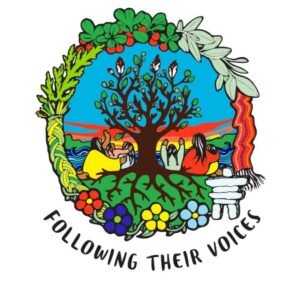
Let’s Do the Time Warp Again: Why We Must Look Back to Move Forward
Do schools really need to change? Reading the first of this week’s prompts, I found myself shouting “Yes!” at the screen. But what would that change look like, and who (besides Miss Cleo) could accurately predict the new educational systems and policies needed in a world that is still struggling with issues like book banning and the climate crisis?

GIPHY: Miss Cleo.. Is any other Gen X or Xennial having an instant flashback?
Admittedly, the innovative-tech-loving part of me pictures future schools complete with AI classroom assistants and field trips across the galaxy and inside the circulatory system (via Ms. Frizzle-style VR headsets and domes). Of course, this is the same fantastical part of me that still believes I’ll get my Marty McFly-ing DeLorean… someday!

School of the Future, created using Tome AI. The continuing issues with AI-generated human faces and hands both alarm and amuse me.
The rationale me – the one who’s worked alongside a large student demographic without consistent electricity let alone WiFi – knows better. As educator, Vicki Albritton, notes in What’s the Future of Education? Teachers Respond,
“The classroom hasn’t changed much in the past 50 years. Even the bell design is the same as it was 50 years ago.”
Technological progress is lightning-quick, but the ever-growing digital divide slows its reach, especially in budget-plagued schools. The Western tendency to overemphasize technological progress and students’ digital competencies as societal cure-alls disregards more holistic solutions for essential school reform and student preparedness.
So, how do we change school frameworks and prepare students for the future? Rather than gaze too far ahead, let us look back…
When “New” Skills Aren’t So New
After numerous undergrad classes, PD seminars, and nearly two decades of field experience (AKA: teaching), I only found an educational design I truly believed in three years ago. Based on Indigenous knowledge systems, Following Their Voices (FTV) programming amplifies historically marginalized voices and holistically benefits all students with culturally inclusive and responsive practices, land-based learning, community engagement, equity and social justice, and student empowerment. These traditional skills and practices remain relevant and desperately necessary in a suffering capitalist world.

Photo credit: Following Their Voices Program
When reading the “new” skills examined in Confronting the Challenges of Participatory Culture: Media Education for the 21st Century, I was reminded that technological skills (so highly coveted by Western systems) are neither new nor mutually exclusive from traditional Indigenous frameworks.
- Play as a form of experimentation and problem-solving is a time-honoured Indigenous method of experiential learning (via oral traditions, dances, ceremonies, and games).
- Simulation of dynamic real-world processes has guided Indigenous hunting, agriculture, and resource management for generations.
- Distributed cognition is evident in everything from Indigenous tools to artistry. In their 2013 study, Chahine & Kinuthia explore how the Zulu culture uses beadwork and basketry to communicate specialized mathematical knowledge.
- Collective knowledge represents the core of Indigenous ways of knowing and being. Knowledge is generationally shared and decision-making often involves communal input on behalf of the collective good.
These examples represent only a handful of the parallels between the “new” skills required of students and the ancestral Indigenous wisdom brushed aside by colonialism.
What could the future look like for our students if we combined Indigenous knowledge with digital citizenship? As they say, we need not reinvent the wheel.
What Was Old is New Again

Spiral Speak by Sam Brown, shows the interconnectedness of all things.
To weave a new educational framework from Indigenous traditional knowledge and rapid technological advancements, we must be willing to rework long-held biases and Eurocentric epistemologies.
In a world struggling with issues like racism, sexism, the climate crisis, and digital disconnect, this compelling combination could mean the following for our students and educational design:
- Cultural relevance and inclusivity:
- Creating and utilizing digital archives/repositories of Indigenous knowledge (oral histories, stories, songs, languages, and ecological knowledge willingly shared) and accessing community Indigenous Elders and Knowledge-Keepers (when possible).
- Validating the rich cultural heritage in Canada and the intergenerational gift of Indigenous wisdom (for all), while providing a sense of belonging and pride in Indigenous students.
- Breaking down stereotypes and biases:
- Infusing Indigenous perspectives (particularly interconnectedness and reciprocity) in all subject areas and developing online platforms with multimedia content, storytelling, and simulations.
- Collaborative online projects working with Indigenous and global communities by creating educational websites, videos, documentaries, and forums.
- Environmental stewardship to combat the climate crisis:
- Land-based learning combined with geographic information systems (GIS) that allows students to map Indigenous lands, treaty territories, migration patterns, traditional hunting routes, and resources.
- Fostering a reconnection to the land and sustainable agriculture/resource management based on traditional Indigenous practices and a reciprocal relationship with our planet.
- Active citizenship/Holistic worldview:
- Establishing online and in-person (when possible) mentorship programs connecting Indigenous Elders and Knowledge-Keepers with students to teach empathy, critical thinking, adaptation/resiliency, and interdisciplinary/cross-cultural understanding.
- Additionally, online and VR exposure to diverse global community perspectives.
- Combining the 7 Grandfathers Teachings of the Ojibwe into digital citizenship and media literacy programming.
- Exploring, promoting, and co-creating social justice projects on social media, allowing students to advocate for a more equitable and sustainable world.
- Establishing online and in-person (when possible) mentorship programs connecting Indigenous Elders and Knowledge-Keepers with students to teach empathy, critical thinking, adaptation/resiliency, and interdisciplinary/cross-cultural understanding.
- Reconciliation and Healing: (*most importantly)
- The integration of Indigenous knowledge in future educational design and technology aligns with the Truth and Reconciliation Commission’s (TRC) Calls to Action.
- By creating space in our schools (physically and digitally) for healing, dialogue, and mutual understanding, we create a more positive educational framework and future for our Indigenous and non-Indigenous students.

Photo credit: Acts of Green / The Iroquois Seventh Generation Principle.
Past Wisdom; Future Vision
While I still dream of emerging educational technology and its potential to shape our students’ futures, a more inclusive, equitable, and sustainable world for future generations must be grounded in ancestral teachings. AI and robotics will never capture the empathetic, reciprocal heart of teaching. Instead, the future of education lies in empowering our students with intrinsic, intergenerational wisdom and digital awareness so they can live both in this world and beyond it. I don’t know if I will live long enough to see this potential reform, but, of course, that was never the point.
“Blessed is he who plants trees under whose shade he will never sit.” – Indigenous proverb
POINTS TO PONDER
Feel free to answer any of the following or please respond with any of your own reflections/experiences:
- Do you believe there is a need for change in our education system? What does the path forward look like in your mind?
- Can you think of any other ways Indigenous knowledge can be blended with the “new” skills required for students?
- What role do you believe we – as educators – will play in future educational opportunities and challenges?
As always Kim you make some excellent points, however it pains me that programs such as this haven’t found wider acceptance and implementation. I don’t wish to make this a political comment, but our province seems to literally be pulling in the opposite direction of FTV. We seem to want more pipelines, more provincial independence (why on earth does Saskatchewan need an additional police force?), and our government is attacking the rights of LGBTQ2S+ students. I feel like I am living in an alternate timeline where someone accidently made a change to the past and has hurtled us into a dystopian future. I think the future of schooling is going to be, out of necessity, teachers actively defending the rights of our students and resisting the resurgence of neo conservative policies that threaten the rights of kids. This in addition to navigating the difficulties of actually doing our job has me feeling…tired.
I know, Matt! I agree wholeheartedly. This was my attempt at outlining what I hope for and will continue to work toward, almost entirely at odds with our government sadly. I am tired, too…but there’s a little fight left in me (as I know there is in you).
Kim, I love these points you bring up! I agree that to pave a way forward we should spend some time broadening our horizons and looking in the rear view mirror. FTV is a fantastic example of how to do this to reimagine what education can look like in the future.
Thanks, Cole!
I really wish the government would move further in this direction and provide additional funding (pipe dream?). I firmly believe it is the right combination on ancestral knowledge, student empowerment, and digital literacy. I’m glad others feel the same.
Thanks so much for this post! I hadn’t heard of FTV but as someone who has focused a lot on culturally responsive pedagogy (including Indigenous education) over the past few years this really spoke to me. I do believe that there is a leash around education that seems to be getting tighter and tighter. I really would love to see more programming like FTV that could also help us use our digital spaces in effective ways while revising a more holistic approach to education.
Thanks Kendyll,
I definitely agree about that unfortunate leash held tightly by the purse strings and interests of our government. I’m happy I could introduce you to FTV and I hope you learn more about it. The more people who know about it and work toward having it in schools, the better!